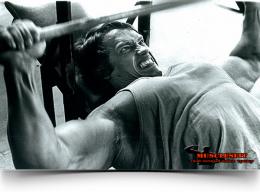Bench press. The most complete guide.
My respect, dear readers! Today I am glad to present to your attention another “tasty” article, which will be devoted to such an exercise as bench press. I think many beginners have trouble with it, and therefore there is nothing easier than telling you about the mistakes in its implementation, the correct technique and, of course, how you can increase your “bench” indicators. We will talk about this and much more in our article.
So let's start our story.
Theory and practice of bench press
What do you think is the most popular exercise in any gym? That's right, bench press. Almost any more or less experienced athlete does it, and even beginners are simply delighted with it. I don’t know about you, but in our rocking chair you constantly boil right next to the bench with a barbell. Everyone is literally vying with each other to line up in order to make the coveted bench press. But these are still flowers, but berries begin when you see that almost everyone has their own unique technique for performing it. Sometimes you look like this and think to yourself: “But men don’t know” :).
Indeed, the mass character and popularity to some extent left their mark on this exercise. After all, it seems that if it is massive, then everything is simple - press yourself and press, and you don’t need to know any special technique, but this is far from the case.
Many initially coming to the gym, immediately lay down the wrong bench press technique, make mistakes and drag all this “baggage of knowledge” with them until someone directs them on the right path. For many, this exercise is very difficult, i.e., for example, only the pectoral muscle should work, and everyone gets the load, but not her. Many have to consciously abandon this exercise and wait for "better times." There can be only one way out - initially (thoroughly) to understand all the subtleties and nuances of the exercise and tell yourself that you are doing everything right. Well, let's go get enlightened.
Anatomical atlas
We already somehow casually talked about the bench press, for example, in the article. However, our story was superficial and, so to speak, for show (damn, burned). Today we will catch up and learn everything possible and impossible about this most massive gym exercise, of all times and peoples.
And we will start, as usual, with theory.
The bench press is a basic multi-joint free-weight exercise that is best suited for developing strength and mass in the upper body. The main load falls on the pectoralis major muscle, the triceps and deltoids receive additional.

In bodybuilding, there are various bench press options, for example:
- Classical;
It is done lying on your back on a horizontal bench. Starting position - the bar is held strictly on outstretched arms. Lowering occurs until it touches the chest, and then the neck (after a short pause) again squeezed out on outstretched arms.
- Press "in touch";
After the barbell touches the chest lightly, it instantly moves up powerfully.
- Bench press in the frame;
The athlete takes a position inside the power rack. The initial position of the bar is the location on the limiters installed at chest levels. Usually this option is used if the athlete has a certain injury that limits the amplitude of the movement of the projectile, or when there is no safety partner nearby.
- Bench press in Smith's simulator;
Runtime errors
Of course, as in any exercise, quite a lot of mistakes are made in the bench press, therefore, knowing the “enemy in the face”, you will no longer need to think about them. So, let's start in order, I made the top 7 mistakes made by everyone who crossed the threshold of the gym and lay down on the bench for bench presses.
Mistake #1. Bad workout
Very often, many people neglect the warm-up, thinking that this is a useless exercise that does not bring any benefit, except for wasting time and effort. So, if you "score" on a warm-up, especially before serious multi-joint exercises, then unpleasant consequences are guaranteed for you. Therefore, thoroughly heat the frying pan of the muscles of the upper shoulder girdle and lumbar region, because they will experience a serious load.
Mistake #2. Wrong grip
If you are working with small “pressing weights”, then an “open” grip (thumb adjacent to the rest) can be used quite well. When increasing the weight of the projectile, it is necessary to use only a “closed” grip (the neck is in the ring between the fingers).
Mistake #3. Independent removal of the rod from the racks
Many very often (especially in the last heavy approaches) try to independently remove the barbell from the racks and bring it to the chest. It is highly undesirable to do so, because. for muscles, eat under weight - an extremely unnatural and traumatic movement.
Mistake #4. I am a bridge
Most beginner athletes, when doing the bench press, become in the so-called “bridge” lotus position (tearing the pelvis off the bench and arching the lower back up). This technique reduces the range of movement of the projectile and simplifies the exercise, however, if you have weak back muscles, this can lead to injury.
Mistake #5. "Lone wolf"
Not everyone in the gym has a safety partner. However, when working even with moderate weights, it is extremely necessary. A partner will always help in difficult times and lift a heavy burden from you.
Mistake #6. Partner's incompetence
It happens very often that there is a partner, but his qualifications leave much to be desired. Incorrectly performing insurance or clicking ... mmm ... with the face of the moment of assistance, the partner can only harm you. Therefore, either the “insurer” is experienced, or the chest is resting today.
Mistake #7. spring
Very often, many beginners use the trampoline or spring technique. It consists in the fact that when lowering the bar, they slightly spring the “pressure” with the chest. So, doing this is not only wrong, but also dangerous, because you can get microcracks in the ribs latently.
Actually, these are the main errors that occur when executing bench press.
Execution technique
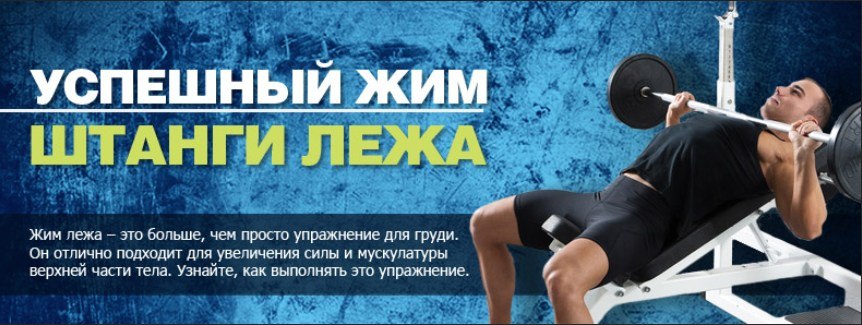
At first glance, it might seem that the bar press is probably the simplest movement in bodybuilding. And it’s true, what’s so complicated about it, I lay down more comfortably and “jiggled” harder. However, in reality, everything is much more complicated, because in order to correctly perform this multi-joint exercise, you need to know the physiological basis of muscle work. We will talk about them later, but first ...
I would like to say that the bench press is an exercise that gathers the most spectators in the rocking chair, when someone does it and takes more or less decent weight, the whole room freezes in anticipation with thoughts - will they take it or not? And if the declared weight is subdued, it seriously increases your rating in the eyes of fellow iron and adds a myriad of karma points to your piggy bank.
So, let's move on to theoretical practice.
Doing any exercise (even isolated) at least two muscles are always involved in the work. In turn, they are all divided into: synergists and antagonists. The flexor muscles are antagonistic to the extensor muscles. Synergists are those muscles that work in one direction.
Note:
Antagonist muscles: biceps-triceps, latissimus dorsi-pectoralis.
When performing any movement, the muscles work not only in their usual physiological modes, but also in a specific mode - they develop a static force. Those. they help to perform the exercise technically correctly, stabilizing the position of different parts of the body.
Muscles take part in the work in different ways and take on the load - who is more, who is less, in other words, the muscles can be divided into:
- main driving units (ND/VD) ;
- engineering units (C) .
The first include the muscles that make the greatest contribution to the developed power effort of the exercise, these are the so-called main / direct movers (ND). Also, the first ones include auxiliary propulsors (AD) - synergistic muscles that work in the same direction with the main muscles and help move the limb.
The second includes stabilizers (C) - they help to perform the movement technically correctly, fixing the posture and position of various parts of the body with powerful efforts.
Understanding which muscles form the basis of the exercises, it will be easier for you to perform them. In addition, you can choose the best exercises for the development of the muscle groups you need. Because our task for today is to learn how to technically correctly and correctly perform the bench press, so the following image (clickable)demonstrating the muscles and exercises, the role of which is especially great when doing the press, will be most welcome.
By performing the above exercises, you will powerfully develop the anatomical atlas of the muscles involved in the bench press, which, ultimately, will allow you to increase your muscle volume and strength.
Well, now let's move on, directly, to the technical part.
I will tell you a secret secret. In the bench press, I always had a rather weak feeling of the pectoral muscles, i.e. no, my triceps or shoulders didn’t get tired, I just felt that the pectoral “filony”. Of course, the first thing I did was once again pay attention to the technique and made some adjustments, and my second step was to work out the main and auxiliary muscles-motors.
So, as for the correct technique for performing the classic barbell bench press with free weight, it looks like this.
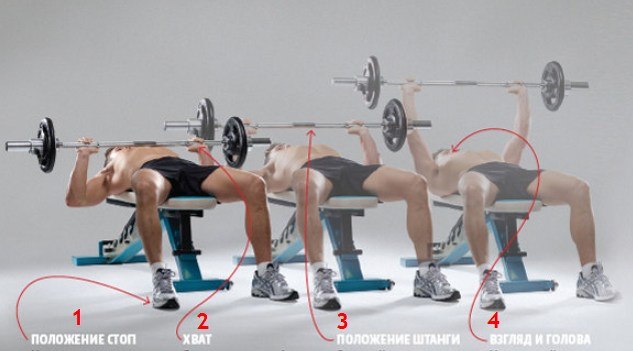
On the move so...
- Stop position ( 1 )
The power success of the entire exercise depends on how the athlete lies down and what position his feet take. It is necessary to spread the feet fairly wide (shoulder width apart) and firmly fix them on the floor. They should not “slide” when you press the weight. Press firmly into the floor throughout the exercise. The muscles of the thighs and buttocks are tense, they should lift you slightly from the bench, but the pelvis should not tear off. It is necessary to bend well in the lower back. Fix yourself in such a tense position.
- grip ( 2 )
Grab the bar with a wide (closed) grip. Often there are special notches on the neck to more accurately determine the position of the grip width, but it should be understood that they are not universal and are only suitable for “standard” guys. In general, the width depends on your height, the structure of the shoulder joints, the length of the arms, and so on. In the grip, it is best to focus on the verticality of the forearms at the lowest point of the trajectory. Keep the bar as close to the base of the palm as possible, do not allow it to fall to the base of the fingers. Squeeze the bar with sufficient force. Keep your elbows strictly under the bar. The pressing movement occurs in one plane.
- Bar position ( 3 )
The reference point for lowering the bar may not be any particular section of the sternum (most often middle), but an imaginary line connecting your elbows. The barbell is closer to the face, the wider the elbows are. Lowering the bar should be slower than squeezing it out. At the bottom of the trajectory, you need to make a distinct second pause. The bar is squeezed out on exhalation (on inspiration - lowering) powerful force of the entire musculature.
- Look and head 4 )
Do not turn your head and do not tear off the back of your head from the bench - this can provoke a rounding of the entire spinal column and a weakening of the bench as a whole. Before removing the barbell from the racks: pull the shoulder blades together, lower the shoulders and tighten the muscles of the neck, moving the head back. Direct your gaze strictly to the center of the neck, and not to the passing by.
Note:
The absolute world “bench” record (in equipment) belongs to the American Tiny Meeker, it is fixed at the mark 488,5 kg in 2013 year. Russian falcon Vladimir Kravtsov squeezed (without equipment) a barbell with a weight 303, 5 kg and thus established (in 2011 year) the absolute record of Russia and Europe in the bench press.
Now that you have a general understanding of the technique for performing the exercise, it's time to get acquainted with the different variations of the bench press.
Variations
By changing the grip and using different angles of the bench, you can work out different muscle groups. For example, the following options for performing a bench press are possible.

Option number 1. Close Grip Press
When pressing with a narrow grip ( 1 ) the emphasis shifts to working out the triceps. The palms are located at a distance of about 10 see apart. When pressing with a narrow grip, you can lower your elbows down (i.e., so that they slide along the body), or you can spread them apart.
Option number 2. Reverse press
Taking the barbell with palms facing you, the emphasis shifts to the top of the chest and the pectoral muscles more effectively (by 25% ) are included in the work.
Option number 3. Bench Press
The upside-down press works more on the lower chest and, due to the shortened amplitude, allows you to use more solid (compared to classic) working weights.
Phew, it seems that we mastered most of the becoming, but that's not all, because for dessert I cooked something else delicious.
How to improve your bench press performance?
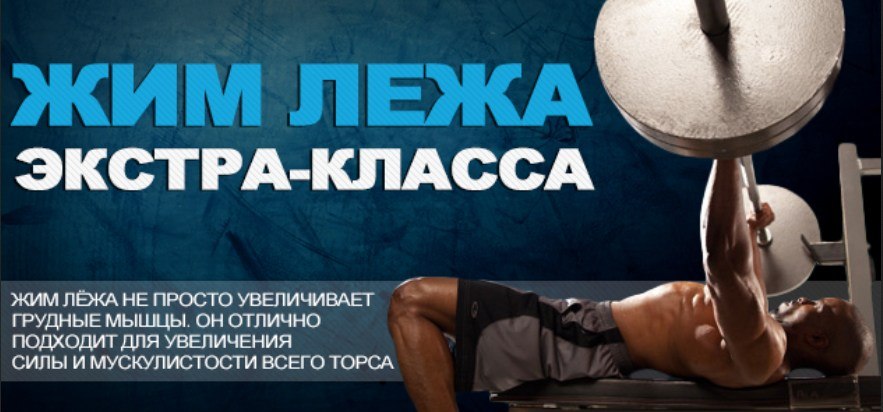
What inhabitant of the gym does not want to increase his “bench” performance. At least I haven't seen them in my lifetime. If an athlete manages to curb a sufficiently large weight, then a muscular torso is just his sentence. However, many, no matter how hard they try, cannot add even a few tens of grams to the barbell, not to mention more intelligible weights.
The whole point here is that most often an athlete relies on intuition and Russian maybe, like: “what if I try, it will suddenly turn out to take more”. Such an approach in such a responsible matter is completely unacceptable. To accomplish this task, first, you need to understand that even if you do not naturally have a massive pectoral muscle, you can still push big weights. To do this, you just need to competently make an effort and involve in the work not only the main, but also all the auxiliary muscles. As soon as the “starting point of support” is created, you will immediately notice an increase in working weights.
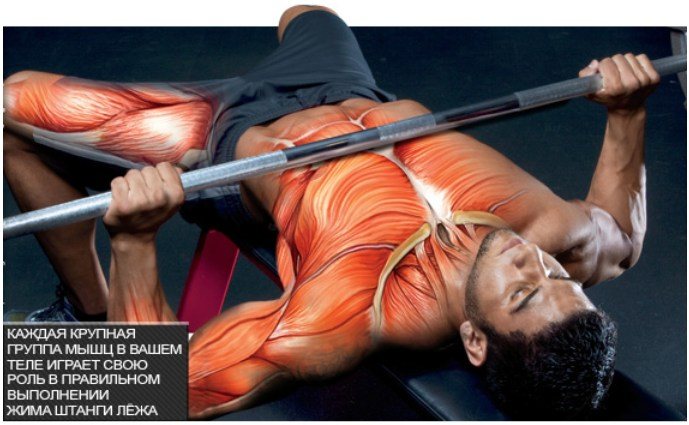
Starting the exercise
In order to powerfully and effectively push the projectile from the chest, it is necessary to train the legs. At first glance, this may seem like complete nonsense, but only at first glance. The whole point here is that at the bottom point your body looks like a spring, the potential energy of which is in the legs. If you have weak legs, then this spring will “barely” decompress, and you can simply forget about large working weights in the bench press and a powerful push from the chest. Therefore, strengthen the bottom (legs) by doing and, as well as the muscles of the core.
The foundation
From the outside, it may seem that all the “rough” work in the bench press is performed only by the pectoral muscles and arms. This is not entirely true. As soon as you train your lower body and begin to use it in the exercise, the back muscles will immediately join the work. They will accelerate the upward movement of the neck and contribute to a more powerful push.
Therefore, develop your back muscles by doing various tractions on block simulators and with free weight (T-bar). Read the article and also include this exercise in your back workout arsenal.
stability and shoulders
Work out your pace and rhythm of the movement of the bar and stick to it. Perform all movements clearly and under control, do not rush anywhere. Developed shoulders are your lifesaver when working with serious weights. After all, it is they who help to stably hold a large tonnage and protect other muscles from injury.
Best of all, strengthening the shoulders will contribute to the military bench press.
Completion of the movement
In fact, the bench press is nothing more than lowering down and lifting / pressing the projectile to the top point. If your triceps are weak (particularly its long head), then evenly “pushing” the bar to the top will become a problematic task for you. Therefore, train your long head with a French press and a close grip, do various extensions on the blocks, all this will allow you to “pull” more weights.
Remember, if the bench does not go, then go over all these points again, maybe you missed something. In addition to the basic rules, take note of the following:
- strong grip;
Grip the bar firmly, imagine you want to leave your prints on it.
- make the most of your strong muscle groups and reduce the involvement of the weak in the work;
Most often, the bar stops at the point where the action of strong muscles ends and weak muscles are included in the work. By changing the width of the grip, you can easily find the optimal point of application of force.
- lowering and raising the neck;
Having removed the barbell from the racks, do not “hang” with it, but immediately perform the exercise. Lead the bar in a straight line, because this is the shortest distance between 2 points.
- the optimal number of approaches and repetitions;
Do not do too few or, conversely, too many sets and repetitions. 6-10 repetitions in 3-4 approaches - for weight gain and 2-5 repetitions in 6-8 strength approaches.
- once a chest workout 5 days, no more 2 consecutive days;
Do not “pound” the chest more 2 once a week, because in addition to the specific recovery of the muscle group, there should also be a systemic one - the rest of the whole body and the central nervous system from training.
- work on technique;
Hone the technique of movement and do not weaken the form of the exercise. If you began to notice behind yourself that in the last repetitions there is no technique at all, this is an occasion to unload the bar. Work with moderate weights, but in a "strict" technique.
- brain power;
The mental attitude to weight is also important. Concentrate and imagine in your mind how you perform the bench press. Creative visualization is imagining the end result and playing the picture in your head. First imagine the picture, and then transfer it to reality. Let your brain squeeze out a lot of weight first, and your body will soon follow suit.
So, we have analyzed the main chips that will help you to “press” well. However, that's not all.
If your goal is to make the most progress in the bench press, then the following training plan will be just right for you.

You need, first of all, to determine your “extreme” in the bench press, i.e. the weight that you can do strictly on 1 once. The following formula may well be suitable for this.
The training program itself, which should prepare you for doing a steep bench press, will look like this ().
Actually, this is probably all, otherwise I already see how you “peck” with your nose :).
Afterword
So our next titanic work called the bench press has come to its logical conclusion. I think you have learned a lot today, and you are already eager to try it all out in practice, i.e. in the gym. Well, I don’t dare to detain you, my dears, see you in the rocking chair!
PS. If you have any questions or something does not work out in the bench press, write them in the comments, we will be happy to sort everything out!


